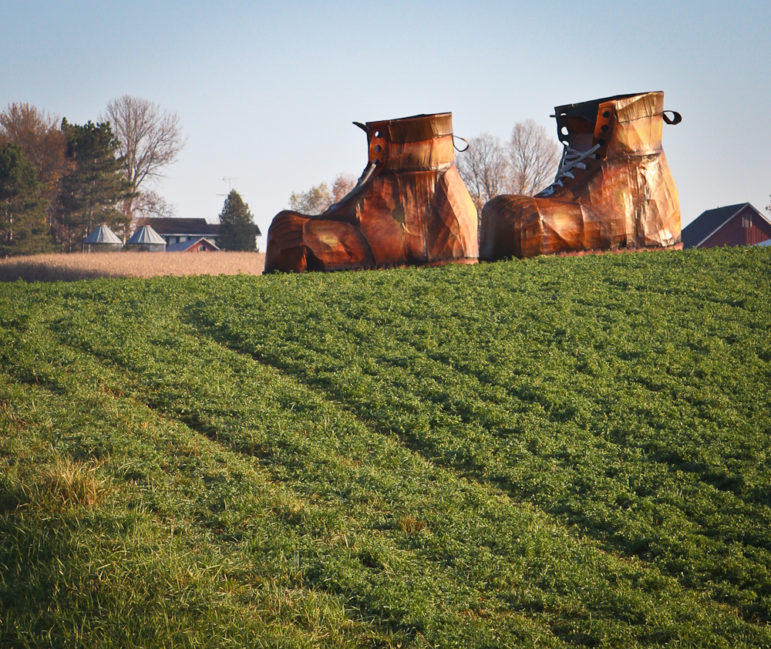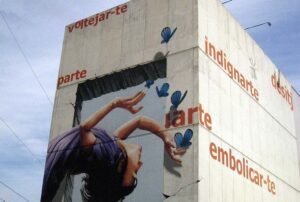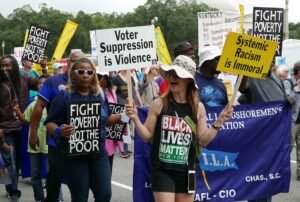
This piece is part of our ongoing Equity, Diversity, and Inclusion (EDI) Project created to spotlight millennials’ voices and thoughts on diversity and justice. We urge you to read how this project came together in collaboration between NPQ and the Young Nonprofit Professionals Network and about the ideology behind this series. We intend to publish another 17 pieces in the coming months. Readers will be able to subscribe to an RSS feed to follow articles as they are published. NPQ and YNPN will be using the hashtag #EDISeries, so post about the series along with us.
To stay informed of the project, we also encourage readers to sign up for our daily newsletter, on the right side of this page. If you have any questions or would like more information about the EDI Project, please email [email protected].
What does it look like to be working deeply on core issues of equity in a collaborative that was born out of power and privilege? It is a core question of practice, and yet is largely ignored in practical terms. While inclusion and engagement may be stated values of many collaboratives, are there other value sets working against these ideals? Is predictability and stability valued over disruption? Does surface civility rate more highly than a real exploration of differences? What effects do these cultural prerogatives have over inclusion?
I came of age when universities had just begun rolling out nonprofit management degrees and when organizational capacity was becoming a critical consideration. So, those of us at the very tail end of Generation X emerged into a sector that embraced community organizing and engagement while at the same time adopting more rigid organizational structures. While this trend may ultimately result in nonprofits with stronger traditional board governance, clearer financial documents, and important organizational policies, it may also get in the way of genuine inclusion, and, at the level of organizations’ DNA, result in the stifling and undervaluing of the very voices that should be valued the most.
I currently run a collaborative called Mile High Connects, which focuses on how the Denver region’s expanding transit system can be leveraged to enhance access to opportunity for low-income communities and communities of color by connecting them to affordable housing, healthy environments, quality education, and well-paying jobs. Since 2011, Mile High Connects has served as a central backbone organization, influencing local and regional policies, leveraging and deploying resources, and engaging those most affected in decision-making processes that impact their lives.
Historically, the Denver region has had a legacy of transit equity work, with Atlantis Community and ADAPT emerging out of bus protests in Denver in the 1970s and laying the foundation for the creation of the Americans with Disabilities Act. With a $7.8 billion public investment to expand our regional rail system, both nonprofits and philanthropy saw a renewed opportunity to ensure that people living near the transit build-out would benefit from the community and economic development that was sure to follow, rather than be displaced. Early work focused on preserving and creating affordable housing near rail stations, negotiating opportunities for local residents to access middle-skilled job opportunities, and ensuring that development was leveraged to bring into neighborhoods needed services such as fresh food, quality child care, and educational opportunities.
As efforts progressed, Mile High Connects began also to focus on issues of basic access to the Denver region’s bus and rail system. Many neighborhoods lack the basic infrastructure such as sidewalks, drainage, and lighting that make it possible to access transit stations. Bus routes with lower ridership are changed without accounting for the fact that they may be the sole means of access to fundamental services like healthcare and educational opportunities for people along those routes. Prices of bus and rail fares and passes are, for many, unaffordable, and most of the existent discount programs offered by our transit agency benefit higher-income—and primarily white—riders. Helping communities to prioritize investment in infrastructure, supporting residents in advocating for reinstatement of bus service routes, and working with over one hundred partners and the transit agency to create an income-based discount fare program have all elevated the issue of transit as a core component of the equity conversation in our region.
Mile High Connects is rooted in the theory that when “grasstops” and “grassroots” actors sit at decision-making tables together, systems change can truly occur. When “grasstops” means powerful white foundation executives, political decision makers, and institutionalized nonprofits, and “grassroots” means small social justice organizations and residents from communities of color, you can imagine how careful we have to be about the power and privilege dynamics between our partners.
Mile High Connects was started by a generous grant from major national funder the Ford Foundation, which challenged other local funders to match its support. We have enjoyed multiple years of investment from these funders, who sit at our decision-making table and are fully committed to the outcomes we are collectively working to achieve. Our founding nonprofit partners have a consistent seat at the decision-making table, too, and receive significant noncompetitive, directed grants to accomplish their own work each year in support of the collaborative’s objectives. In some ways this structure embodies many of the ideals to which we ascribe having to do with the relationship between philanthropy and nonprofits: ongoing, long-term mutual relationships; shared decision making; and flexibility of funding to support collective work. But the structure also reinforces privilege and solidifies a power disparity in which the core collaborative partners have different, and more access to, resources, information, and connections than others working on complementary issues throughout the community—including both residents and other organizations.
Sign up for our free newsletters
Subscribe to NPQ's newsletters to have our top stories delivered directly to your inbox.
By signing up, you agree to our privacy policy and terms of use, and to receive messages from NPQ and our partners.
Last year, we embarked on an internal equity and inclusiveness process to delve more deeply into these issues within our collaborative structure, to ensure that our external values are reflected in our internal culture, structure, and framework. Managing this process for a collaborative whose people at the table are there on a voluntary basis, whose funders sit with us as partners in the process (as do our grantees), and whose staff and steering committee all work off-site—so there are few opportunities for the kind of organic relationships one achieves when working together in an office—has come with its own set of challenges. These challenges have helped me to understand why so few cross-sector collaboratives in our community have taken on this kind of internal inclusiveness work outside their own organizational walls.
I find that, frequently, these conversations can have an added layer of difficulty because so many of us have a hard time separating our personal, professional, political, and sometimes even spiritual identities: we mistake conversations about organizational growth for personal disparagement. This is true for any of the difficult conversations that partners need to have to create strong collaborative structures—conversations about accountability, credit and recognition, funder relationships. But the added layer of very real historic and present pain resulting from our racist cultures, intentionally and unintentionally embedded in our organizational practices and incorporated into our personal beliefs and actions, makes it difficult to both untangle and thread together equity and inclusiveness issues to strengthen our structure and inform our practice.
Our partners agree that bringing together directly impacted residents and decision makers into genuine dialogue and work will achieve different and better results. However, there is less agreement about whether at its core our collaborative is working to dismantle a system of privilege or whether we are using tactics within a system of privilege to get at better outcomes. This question of means and ends is one that does not have a clear answer across our partners. The richness and challenge of bringing together bankers and community organizers, developers and neighborhood advocates, are embedded in this fundamental question.
In any group, people are working along a continuum in their own exploration around issues of equity and inclusion. This creates another challenge. There are those for whom racism is seared across every minute of their lived experience, there are others wishing to be allies while simultaneously scoffing at and diminishing the concept as one of privilege, and there are yet others tired of the discussion and who want to get back to the “real work.” In a collaborative context, where people are coming together as individuals, as representatives of their own organizations, and as members of a collective whole, the complexities multiply. People may be personally in one place on the continuum, their “home” organizational culture may be in another, and the collaborative context may be trying to create a third. I question what happens as we delve into this work to those collaborative members whose own organizations are not immersed, embedded, or even supportive of meaningful internal equity and inclusiveness practices. Will it be harder for them to do this exploration in small doses within our collaborative context rather than having these practices be fundamental to their day-to-day organizational practice? Are we opening people up emotionally only to send them back into unsupportive environments while they are on their own path? Are we developing advocates to create change back in their own individual organizations? The answer to all of these questions is likely yes, and that ripple effect is another reason it is so important for collaborative partnerships to step into this work.
In addition, I often reflect on how even the way inclusiveness work is traditionally done in professionalized nonprofits embodies privilege and approaches this visceral topic from an almost academic lens. As Mile High Connects struggles through the definitions of “horizontal violence,” “white supremacy,” and “pedagogy,” I can’t help but think that where I learn the most about such topics is in neighborhoods where, for instance, I’m the sole English speaker trying to keep up with a dynamic group of Spanish-speaking community leaders in an organizing meeting, directly after which I meet with a group of white, male transit-agency executives who are stretching to understand the implications of a fare increase on the lives of their riders.
As a leader, I struggle with how much of this work comes from leading from behind and how much of it comes from out in front. How do I lead people to ask the right questions and challenge themselves to find the right answers? How do I make sure I am doing this myself? My answer to these questions is desperately imperfect. I work to push through fear and past comfort, to be honest with myself and hear the honest reflections of others, and to pay close attention to group and personal dynamics and engage our partners in these discussions individually as much as collectively. I try to find a pace that furthers our analysis, our commitment, and our success in our equity values without tearing the group apart, knowing I will always be moving both too fast and too slow, directly talking about these issues too much and too little, and devoting both excessive and not enough time and resources for people’s comfort across the range of our partners. It is the nature of leading in a collaborative context, and a reminder that leadership here and perhaps everywhere relies on the tension between balance and push.
I think often about the signs of progress, because they are subtle and slower than any of us would like—but I see them. I see them in tiny ways—when we are engaging as a group in a personal reflection exercise about inclusiveness, and one of our most staunchly professional partners has a moment of emotional openness and vulnerability. I see them when two of our funders tell me about being at an event about a bike share, and how they raised their hands to ask explicitly how it will benefit low-income communities and communities of color. I see them when our work planning begins with a question about what our organizing groups are hearing on the ground, not with what a national study tells us.
So, what does it look like to be working deeply on core issues of equity in a collaborative that was born out of power and privilege? It looks difficult and sometimes hypocritical. It looks messy and beautiful. It looks transformational. It looks like all of these things at once, as we work to unpack our own privilege, use that privilege to support moving a social justice agenda, and understand how to make a real difference informed by and embedded in community.










